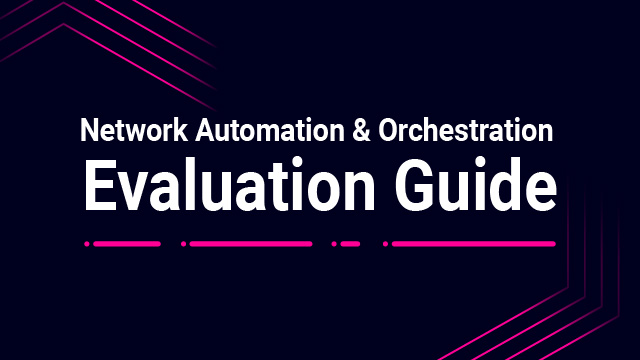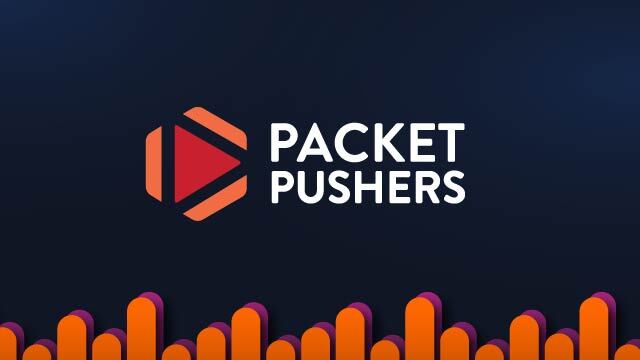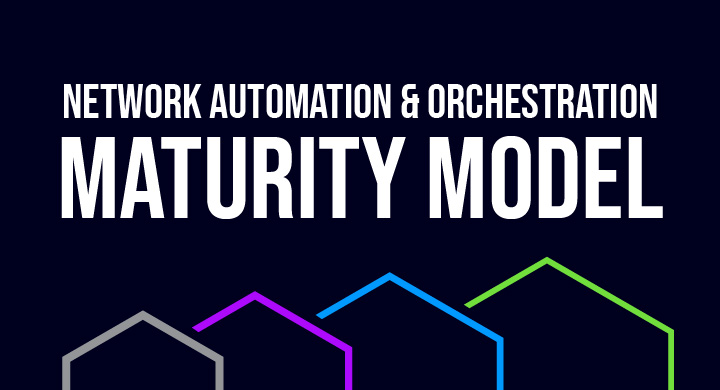Understanding the Key Differences, Use Cases, Capabilities, & Benefits Between Network Automation & Network Orchestration
Network Automation
focuses on repetitive, routine tasks that can be standardized and executed with minimal human intervention, for the goal of reducing manual effort and errors.
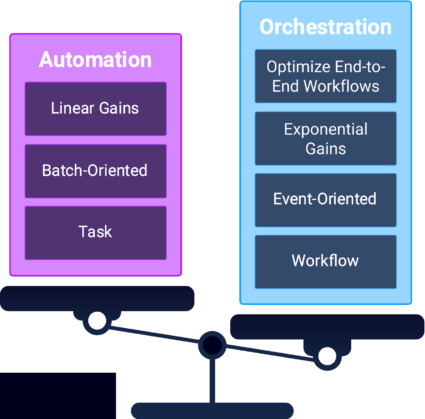
Network Orchestration
focuses on the coordination and integration of automation tasks and other systems and tools, as well as managing the data and relationships between those tasks, delivering an end-to-end coordinated workflow.
Defining the Difference
Network Automation
Characteristics
- Focused on specific tasks, typically applying configuration or collecting operational data.
- Executed from the command line or pipelines.
- Executed by the team that authored the automation.
- Dominated by open source/ DevOps toolsets or python libraries.
- High-code.
- Largely swivel-chair input with limited integration capabilities.
- Generally linear execution with a lack of business logic.
- Typically focused on a single domain.
- Companies typically have many automation strategies and tools.
Benefits
- Task Standardization – Automation focuses on standardizing tasks, making repetitive and routine activities, like configuration and data collection, faster.
- Reduction in Errors – Automation greatly reduces the chances of human error in repetitive tasks, leading to more consistent and reliable outcomes.
- Speed of Execution – Individual tasks can be executed much faster across one or many devices.
Network Orchestration
Characteristics
- Focused on end-to-end processes.
- Executed by external teams (not the author).
- Robust capabilities to integrate and transform data from multiple systems.
- Robust business and operational logic
- Workflow based.
- Multiple teams participate in the creation of workflows.
- Focused on catalogs and exposure to external systems for execution.
- Typically spans multiple domains.
- Companies typically have fewer or singular orchestration strategies.
Benefits
- Workflow Standardization – Orchestration is about coordinating and managing complex workflows across various automated tasks and systems.
- System-Wide Efficiency – While automation improves individual tasks, orchestration enhances the efficiency of entire systems and workflows.
- Flexibility – Orchestration allows for abstracting specific components to adapt to a changing infrastructure landscape.
- Participation – allows for multi-disciplinary groups to participate in delivering outcomes.
Network Automation
Domain-Specific, Task Focused
Automation happens at the domain level, where tasks are automated using tools. Tasks like configuration changes and device provisioning can be automated using tools like Python, Ansible, and vendor-specific solutions such as SD-WAN controllers. Teams who build automations are focused on solving pain points that they experience in their day-to-day work, in their own technology domain. Automating domain-level networking activities works great for individuals, but its impact is multiplied when automations can be shared with their teams, keeping up with the growing scale of network infrastructure. The right automation platform can make it easy for teams to share their automations in a secure way, expanding the impact and reach of every automation an engineer builds.
Packet Pushers: Evolving from Python to Platforms for Network Automation
Itential for Network Automation
To keep up with today’s distributed infrastructure, network engineers are building automations with open source tools like Python, Ansible, and Terraform, each with their own unique environment – lacking the ability to both securely share automations across teams and expose automations for more methods of consumption.
Itential provides the only platform that supports all your existing Python, Playbooks, and Plans, and provides the enterprise-grade features you need to get back to building automations and stop wasting time building applications to support them.
With Itential’s Automation Service network engineers can secure, organize, share, and execute their network automations, across all network domains, through one central platform.
Central Management for Existing Network Automations
![]()
House your existing automation assets including Ansible Playbooks, Terraform Plans, and internally developed automations. Expose these assets to team members making it simple for anyone to execute automation.
Transform Network Automations into APIs
![]()
Securely share your automations using API interfaces to unify and streamline operational processes with different platforms and programs that exist across your organization. Build APIs for your scripts to enable integration with DevOps Pipelines, CI/CD Platforms, and ITSM Platforms like ServiceNow.
Consolidate & Share Network Automations Across the Organization
![]()
Consolidate all the pockets of automation that exist on different laptops, desktops, and servers and securely manage these automations – enabling more people to run automations across different teams in your organization.
Enterprise-Grade Security for Network Automation
![]()
Built-in RBAC and centralized logging for every one of your network automations. Audit execution with a detailed history that allows teams to know when an automation runs, who ran it, and its results.
Network Orchestration
The Value of Enhancing Automation Efforts
While both network automation and orchestration bring efficiency and speed, automation is more about streamlining individual tasks, and orchestration is focused on efficiently managing and integrating these automated tasks and processes across the entire network or IT system.
The goal of an orchestration approach is to connect siloed automation efforts and evolve to large-scale, end-to-end process orchestration — without disrupting the ways engineers already use automation today. The right technology enables automations to be run by those who need them, whoever and wherever they are, without creating additional security risks.
It’s not about replacing automation tooling; it’s about enhancing the way these technologies are used. Adopting the right platform can transform how an organization approaches automation and orchestration, driving value across today’s large, complex, global networks.
Expected Network Orchestration Capabilities
EXPOSE automation to more types of users, including events, order systems, and CI/CD pipelines.
It should ENHANCE your infrastructure by working directly with other network systems such as network sources of truth, monitoring systems, and AIops to both provide and output the right information to the right place.
And it should EXTEND the value of automation by enabling workflows across all your network domains and by using and improving the use of existing automation assets like Python scripts or Ansible Playbooks.
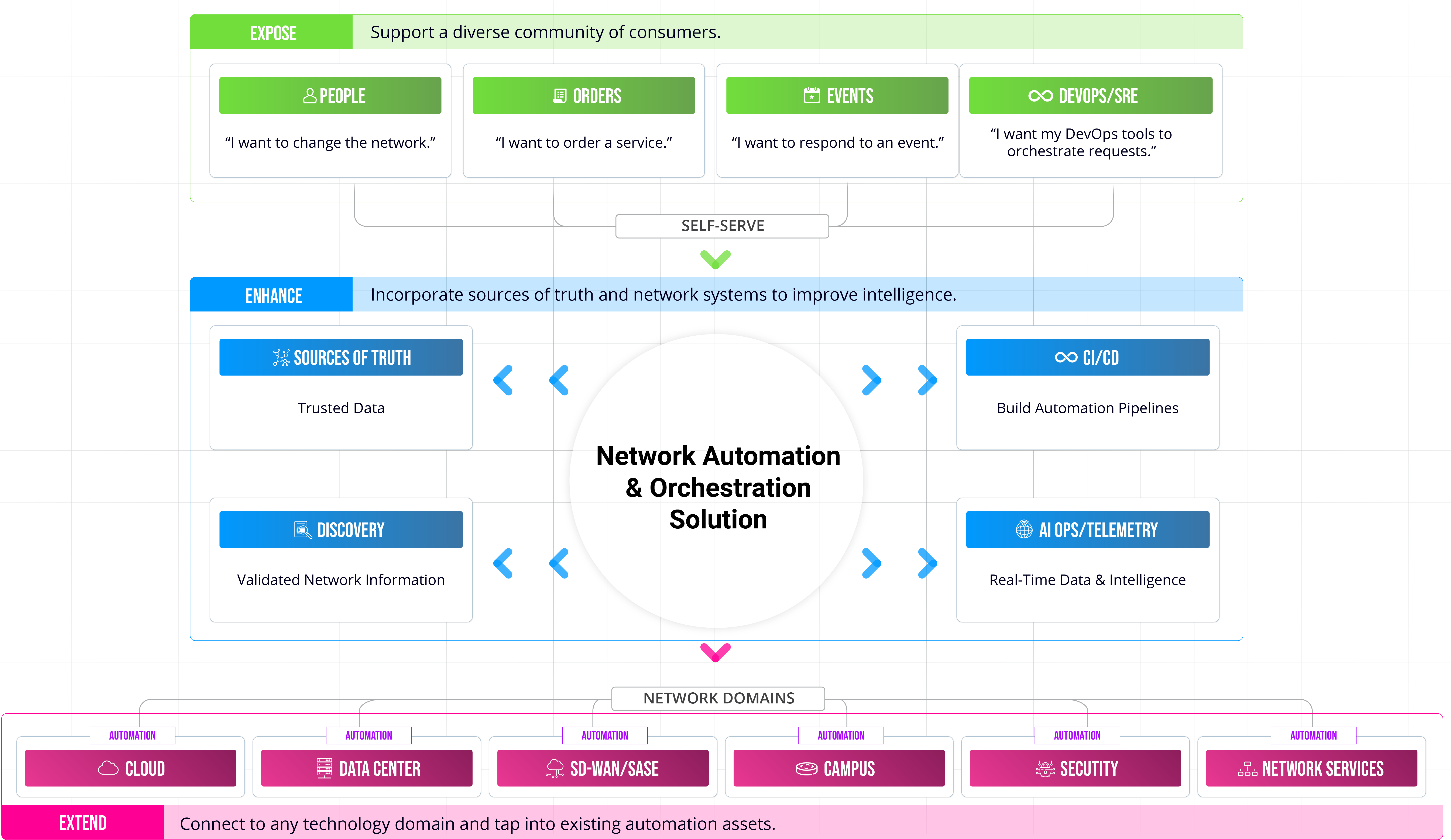
- Leverage Existing Network Automation Investments
Supports existing network automation tools already in place such as Ansible, Python, or Terraform and facilitate orchestrating end-to-end network workflows across these existing automation tools. - Have Turnkey, Generally Available, Supported Integrations
API integrations with IT systems such as ServiceNow, messaging systems such Microsoft Teams, Slack, monitoring and analytics tools such as Splunk, Kentik, etc. - Offer Published, Open, RESTful APIs for Exposure & Self-Service
Vendor published APIs that expose more than 90% of functionality to allow for integration with other tools, the export of data, and provide end-users with self-service capabilities. - Allow for the Creation of Customized Workflows
Ability to create ad hoc dynamic orchestration workflows, which can incorporate logic based on inputs. This must be enabled via a low-code orchestration UI canvas with the ability to ingest and manipulate data from other systems, such as cloud management platforms, ITSM, APM, DDI, NPM, logging services, version control systems. - Treat Public Cloud Services as a First-Class Citizen
Capabilities to automate networking services inside of public cloud providers.
Itential for Network Orchestration
Enterprises have adopted a hybrid model of operation with applications and services hosted in both on-prem data centers and multiple cloud environments. With more applications and services migrating to the cloud, network teams are faced with key challenges around technology integration, skills, and complexity associated with managing bespoke automation domain silos.
Using APIs, networking standards, and software orchestration, the Itential Platform can tie together any networking domain, whether it’s traditional networking infrastructure or software-defined wide-area networking (SD-WAN) branches or public/private cloud and any existing automation tool for end-to-end day 0/1 deployments, day 2 changes and beyond. By taking this approach, organizations can simplify network management, ensure flexibility, and streamline processes.
Integrate with Any Network, IT System, or Automation Library
![]()
Over 300+ out-of-the-box integrations to systems spanning authentication, cloud, controllers and orchestrators, inventory, ITSM, notifications and messaging, SD-WAN, security, telemetry, and analytics as well as custom built automations such as Ansible, Python, and Terraform.
Workflows to Stitch Together a Diverse Set of Domains
![]()
Low-code studio for building reusable and modular workflows that stitch together a diverse set of automations and network domains with IT systems for end-to-end orchestration.
Configuration & Compliance Validation
![]()
Configuration validation through Golden Configuration definition and compliance/validation capabilities across physical network and cloud API services.
Enable Self-Service
![]()
Self-service application that enables teams to define different triggers (APIs, Event-Based, Manual Input Forms, Schedules) to cater to various consumption paradigms.
Manage Stateful Orchestration Aspects of Infrastructure & Services
![]()
Support for both fire-and-forget and stateful approach to orchestration (Day 0, 1, 2+) aspects of infrastructure and services being offered by network and cloud teams.
Provides Ecosystem Applications for Easy Consumption
![]()
Ecosystem applications such as ServiceNow, GitHub Actions, and Salesforce enabling many teams to consume and request with self-service.
External API Consumption Support
![]()
Open API specification for all Itential applications to support consumption of capabilities via external tools like pipelines, portals, and more.
Fully Managed SaaS Offering
![]()
Avoid the burden of deploying and managing infrastructure with Itential’s SaaS-based platform that allows you to deploy quickly and get started in minutes.
Get Started with Itential
Schedule a Custom Demo
Schedule time with our automation experts to explore how our platform can help simplify and accelerate your automation journey.
Take An Interactive Tour
See how Itential products work firsthand in our interactive tours.
Watch Demo Videos
Watch demos of Itential's suite of network automation and orchestration products.
- What’s the Difference Between Network Automation & Network Orchestration?
- Scaling Network Automation: Scripts vs. Integrated Workflows
- More Impact, Same Effort: Orchestrating Your Automations
- Understanding the Direct & Indirect Value Drivers of Network Automation
- Gartner® Hype Cycle for I&O Automation Highlights Shift Towards “Automation-First” & Need for Broader Orchestration
- How Security, Application, & Network Teams Can Reap the Rewards of a Centralized Orchestration Platform
- Why Build AND Buy Is the Model for Network Automation Success
- 2024 Gartner® Market Guide for Infrastructure Automation & Orchestration Tools
- Packet Pushers: Innovating Healthcare IT – Automating NetOps at RUSH University Medical Center
- Evaluating Network Automation Solutions: Top Criteria to Consider
- Evolving from Individual Automation to Team Automation @ NetDevOps Days London 2023
- S&P Global Achieves Same Day Delivery of Network Services Through Automation with Itential
- Extend the Reach of Your Network Automations through Orchestrated Workflows with Itential
- Global Investment Banking Firm Scales Network Automation by Adopting a High-Code + Low-Code Strategy with Itential
